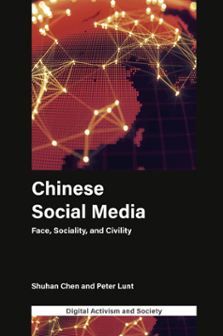
Index
ISBN: 978-1-83909-136-0, eISBN: 978-1-83909-135-3
Publication date: 2 April 2021
Citation
Chen, S. and Lunt, P. (2021), "Index", Chinese Social Media (Digital Activism and Society: Politics, Economy And Culture In Network Communication), Emerald Publishing Limited, Leeds, pp. 149-153. https://doi.org/10.1108/978-1-83909-135-320211005
Publisher
:Emerald Publishing Limited
Copyright © 2021 Shuhan Chen and Peter Lunt. Published under exclusive licence by Emerald Publishing Limited
INDEX
- Prelims
- Chapter 1 China's Compressed Modernisation and Development of Digital and Social Media
- Chapter 2 Social Interaction, Self-Presentation and Face in Chinese and West European Contexts
- Chapter 3 Individualisation, Self-expression and Face
- Chapter 4 Mediated Family Relations at a Distance
- Chapter 5 Online Sociality in Friend Circles: Guanxi and Renqing
- Chapter 6 The New Moral Duty: Spreading Positive Energy Online
- Chapter 7 Conclusions
- Glossary of Terms
- References
- Index